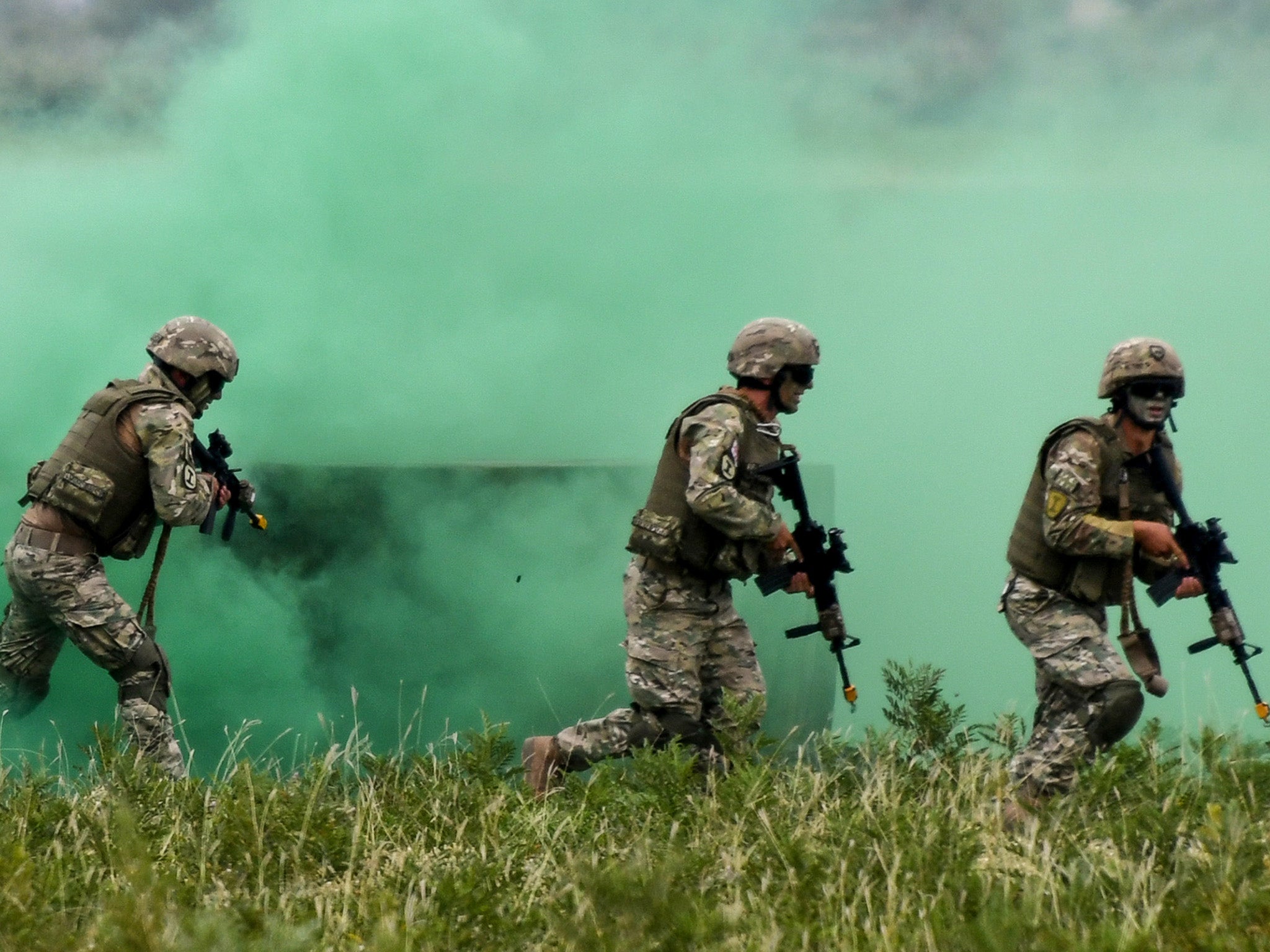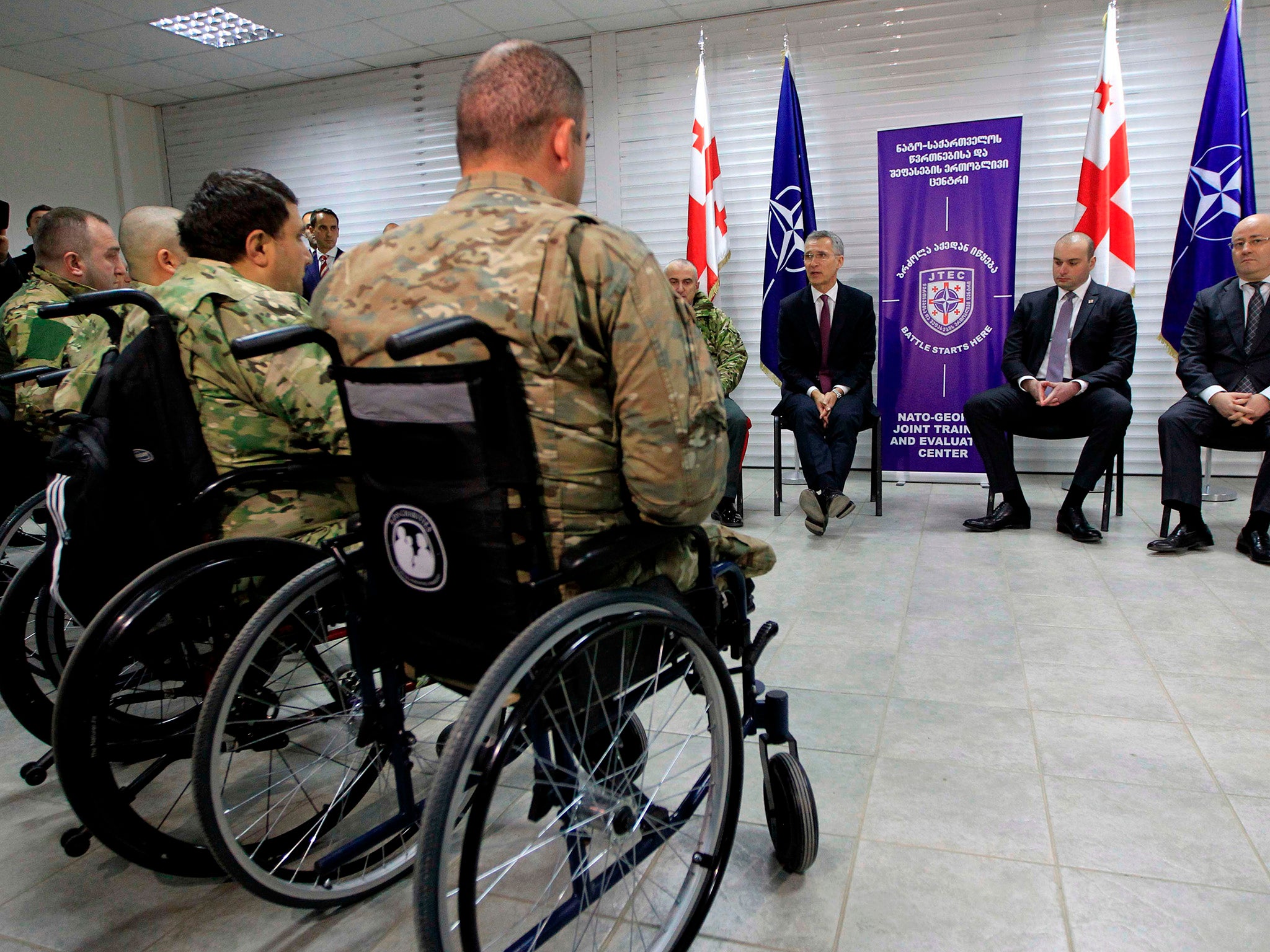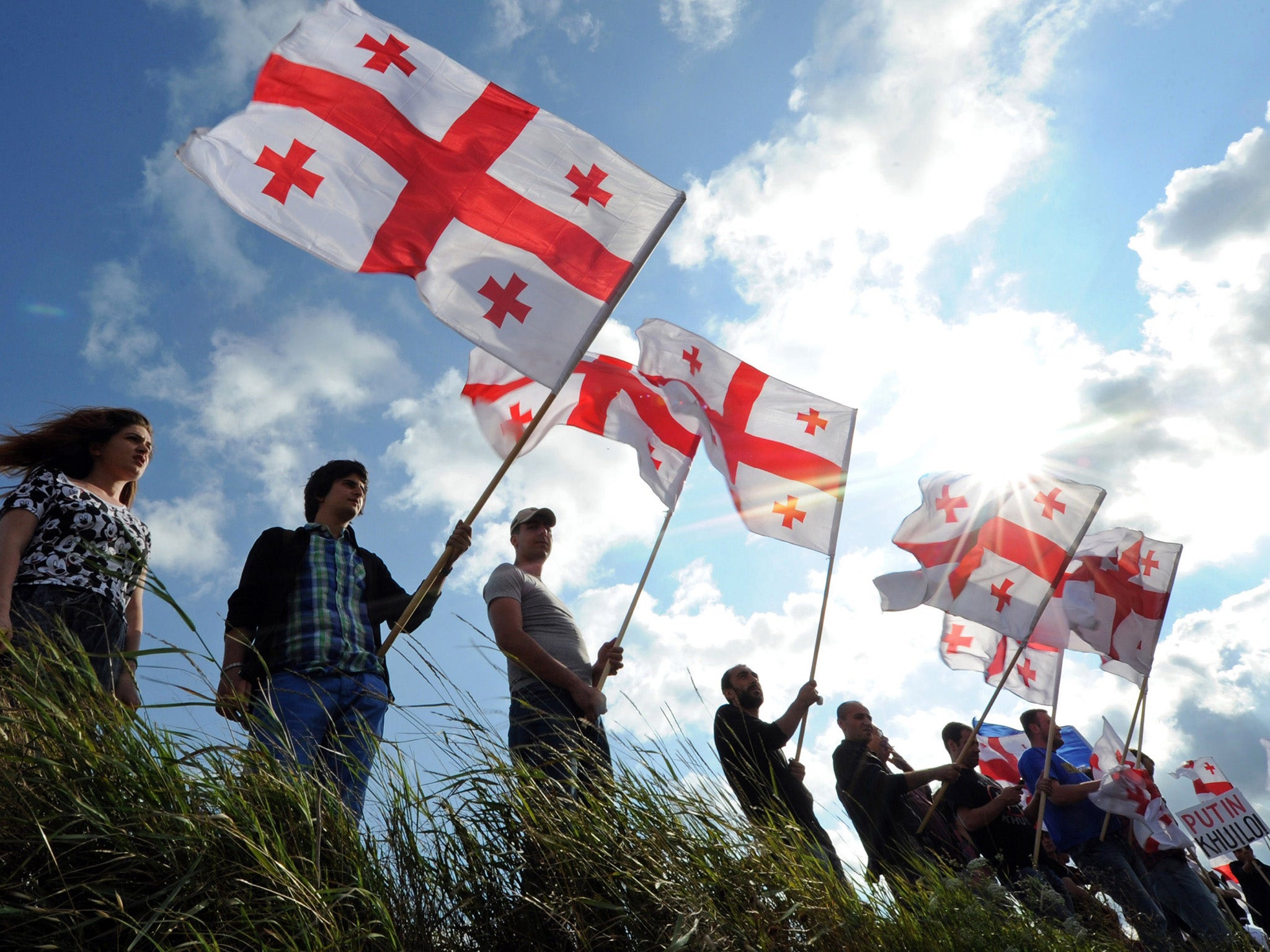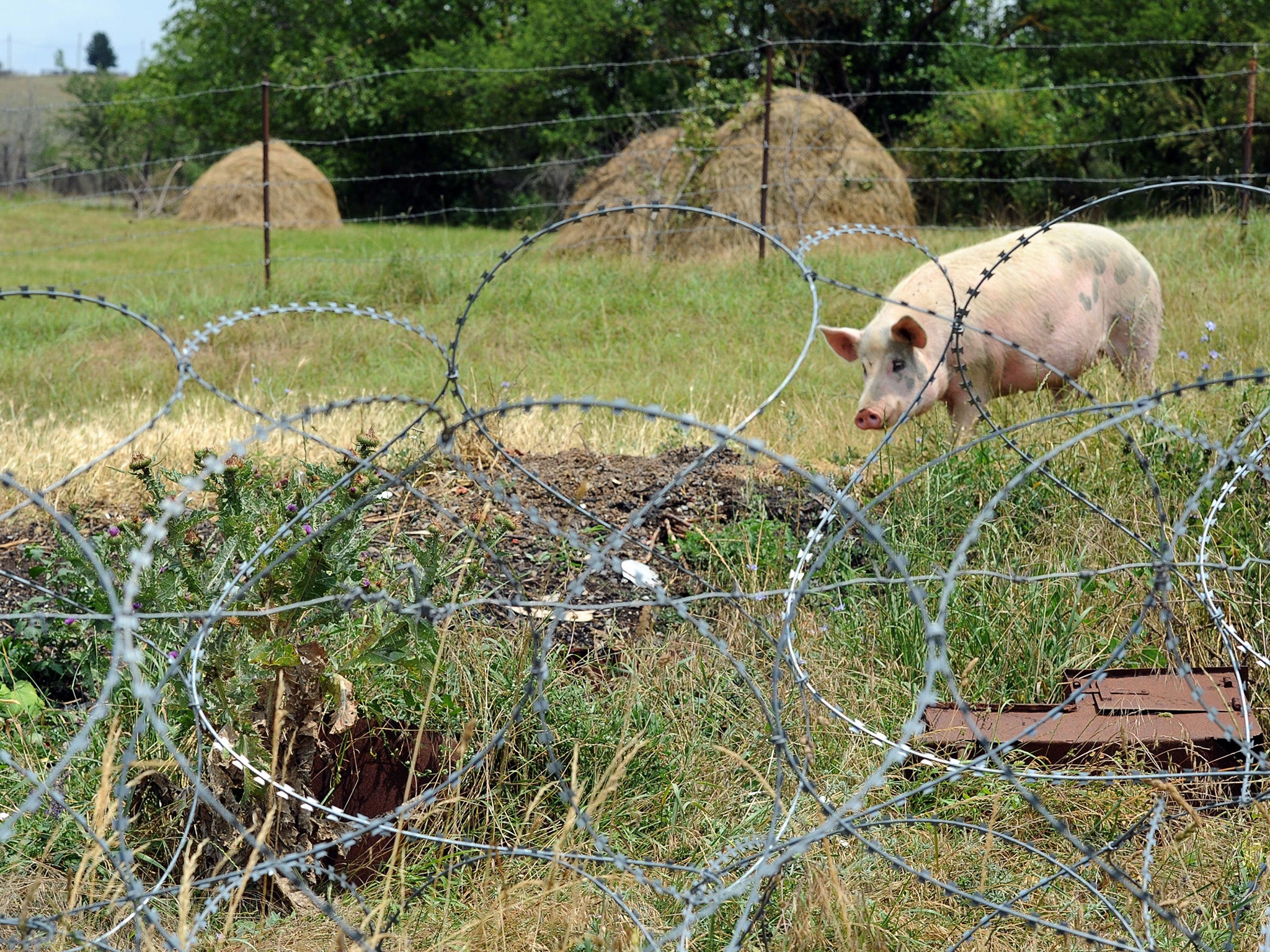Georgia dreams of joining Nato, but its Russian-occupied territories stand in the way
The ex-Soviet state was about to become part of the western alliance in 2008, as long as it met various criteria. But that plan was scuppered when Georgia and Russia went to war for five days. William Cook visits Tbilisi to find out more


In a windswept army base in Georgia, in the shadow of the Caucasus mountains, Nato Secretary General Jens Stoltenberg is meeting Georgian soldiers who’ve been wounded in Afghanistan. Most of them are amputees. One of them is blind. Gravely, sombrely, Stoltenberg thanks them for their service.
“What you have done has been of very great importance for all of us,” he says.
Behind him, the Georgian and Nato flags fly side by side. But Georgia isn’t a member of Nato. So what on earth is going on?
Stoltenberg has come to this army base to inspect a Nato exercise, in which Georgian troops are working alongside troops from many Nato members, including Britain. This isn’t the first exercise Nato has conducted here in Georgia, but it’s the first one where Georgian soldiers have been in charge. For Georgia, this visit is an affirmation of its national identity – as an independent nation, rather than a Russian satellite.
Georgia’s peacekeeping presence in Afghanistan (the biggest commitment of troops, per capita, of any country) is a dramatic demonstration of its commitment to Nato, a commitment that it hopes will eventually be rewarded with Nato membership. Today is a day of speeches, but these maimed soldiers are saying nothing. They’ve paid a huge price for Georgia’s Nato ambitions. Will their sacrifice ever pay off?
Joining Nato is the holy grail of Georgian foreign policy. It’s enshrined in their constitution. Yet despite Stoltenberg’s visit, and this Nato exercise, the realisation of this aspiration remains elusive. For, as everyone here knows, it remains practically impossible for Georgia to join Nato while 20 per cent of its territory remains illegally occupied by Russian troops.
In 2008, Nato announced that Georgia would become a member of the alliance, once the country met the various criteria it requires of aspiring members. However, that plan was scuppered when Georgia and Russia went to war, over two disputed Georgian territories, Abkhazia and South Ossetia. The war only lasted five days, and resulted in a humiliating defeat for Georgia. Eleven years later, the Russians are still there.
The dispute that sparked this war will be familiar to anyone who’s followed the ongoing conflict in eastern Ukraine. This conflict was also caused by the former Soviet republic seeking a closer relationship with the west. Like eastern Ukraine, Abkhazia and South Ossetia contain ethnic minorities, some with independence aspirations. As in eastern Ukraine, Russia has appointed itself their promoter and protector. When the Georgians tried to re-establish control of these two slices of their sovereign territory, the Russian army drove them out. They’ve remained there ever since, constructing and patrolling an ad hoc border which the Georgians refuse to recognise, and making life a misery for anyone who tries to cross this illegal frontier. All attempts to resolve this dispute have so far come to nothing, which is hardly surprising, for this “frozen conflict” actually suits Vladimir Putin very well.

With a history of Russian suppression that stretches back several centuries, Georgia yearns for the collective security of Nato membership, an insurance policy already enjoyed by Baltic states Latvia, Estonia and Lithuania (which, like Georgia and Ukraine, were previously within the USSR). Georgia would love to join them. However the last thing Russia wants is yet another Nato member on its doorstep. Putin knows that as long as this territorial dispute remains unresolved, Nato’s existing members will be extremely reluctant to let Georgia in. So his troops remain in Abkhazia and South Ossetia, stretching Russia’s southern frontier deep into Georgian territory. How long will they remain here? No one (apart from Putin) seems to know.
In the meantime, Nato is doing its utmost to show that Georgia is a valued friend. This Nato exercise, and Stoltenberg’s visit, is all part of the package. Nato has a liaison office in Tbilisi, the Georgian capital. Nato flags fly from the lampposts along Tbilisi’s handsome boulevards. A recent poll of Georgian citizens put support for Nato membership at around 80 per cent. Yet this special relationship is still a long way short of the full membership which Georgia so desires, and that shortfall is a painful reminder of the rampant success of Putin’s Realpolitik. Abkhazia and South Ossetia are rogue states, recognised by only a handful of inconsequential countries. But to Putin that doesn’t matter. For Georgia and Nato, they’re two spanners in the works.
In Tbilisi, Stoltenberg gives a press conference alongside the Georgian prime minister Mamuka Bakhtadze. I ask them what attempts were being made by Georgia and Nato to resolve the issue of Russia’s occupation, and what progress there had been. Stoltenberg’s reply was resolute but downbeat. “Nato calls on Russia to end its recognition of South Ossetia and Abkhazia, and to withdraw its forces from these regions, because these regions are part of Georgia within its internationally recognised borders,” he tells me. “We will never recognise these regions as anything else. They are part of Georgia and we strongly support the territorial integrity of Georgia, including Abkhazia and South Ossetia. The way to solve this is by conducting political talks, to negotiate. It’s not easy and we haven’t seen that much progress.”

A Finnish journalist asks if Georgia could join Nato before this problem had been solved. Here, significantly, Stoltenberg sounded a bit more optimistic. “Nato allies have clearly stated that Georgia will become a member of the alliance, and we are helping Georgia to meet Nato standards, to continue to reform, and then be ready to join,” he tells her. “I am also certain that we will find a way to address and to deal with the issue of South Ossetia and Abkhazia. I’ll not go into details about that now, but we will continue to provide support and Georgia will become a member of the alliance.”
Mr Bakhtadze is more emotional. He talks about a humanitarian disaster, of grave violations of human rights. “We need to give access to our citizens living in the occupied territories to decent healthcare and education,” he says.
For Georgians in these occupied territories, this is a situation strewn with individual tragedies, but what makes it significant for the wider world is that this illegal occupation has become a blueprint for Russian foreign policy writ large. Russia cannot reconquer the independent republics that broke away when the USSR disintegrated, but it can destabilise them, and prevent them from forging closer ties with Nato and the EU. What happened 10 years ago here in Georgia is now happening in Ukraine. Without Nato, something similar could well be happening in the Baltic states.
The big difference between Ukraine and Georgia, and the Baltic states, is that the latter are all Nato members, protected by Article Five of Nato’s founding treaty. The policy states that an armed attack against one member shall be considered an attack against them all. That’s why Russia has invaded Ukraine and Georgia, and why it hasn’t invaded the Baltics. That’s also why Georgia has such an urgent desire to join Nato, and that’s why they’re leading this Nato exercise I’ve come to see today.
Unlike most Nato exercises, this isn’t a battlefield exercise – it’s a command and control exercise. Consequently, there’s not a lot to see. Lots of soldiers huddled over computers. Lots of maps and charts. But that doesn’t mean it’s not important. Command and control is the brains of any military exercise. Without this side of things running smoothly, soldiers in the field wouldn’t have a clue. “As military guys all know, once you get units moving around, if you don’t have the command and control down right it can get very confusing very quickly,” says Colonel William Nemeth of the US marine corps, the mentor and team leader on this exercise.
“It allows a level of difficulty and realism to be injected into a scripted event,” explains Captain Alistair Kay of the royal military police, who’s working on this exercise alongside members of the Georgian military police. “You can train hard, you can fail, you can learn – but it’s also really good to bring together all the multinational partners of Nato in order to deliver this kind of training.” There are soldiers here from more than a dozen Nato members, from Belgium to Bulgaria, from Turkey to the UK. “Everybody knows this is a simulation, but what we’re trying to do is add the real stresses and real demands that you would get in an actual operation.”
All scenarios in Nato exercises are fictitious, but it’s telling that this scenario is humanitarian, casting Georgian forces in a peacekeeping role in a region far removed from its contested Russian border. A famine in the Horn of Africa has sparked civil unrest in an (imaginary) African state called Tytan, exacerbating tensions with its neighbours, ranging from democracies to outlaw states. These soldiers must respond to rapidly changing circumstances, and coordinate the peacekeeping operation out in Africa, thousands of miles away. As Captain Kay says: “The tempo is intense.”
Back in Tbilisi, Georgian minister of defence Levan Izoria explains that Nato membership isn’t just about defence – it also provides a structure within which Georgia can develop as modern, progressive state. “Nato is for us not only a military alliance – it’s more important as a political alliance, because we try to build democratic institutions, rule of law and human rights protection here in our country, and we think the sole foundation for promoting such values is Nato,” he says. “This is not simply integration for us. This is a process in which we want to create institutions, and be part of a rule-based system.”

Georgia has made substantial progress in these areas during the last decade – everything from modernising its armed forces to reforming its judiciary. It already spends 2 per cent of GDP on defence, a Nato target most existing members have yet to meet. Yet the main obstacle to Nato membership remains outside its own control. “Our biggest challenge is the territories which are occupied by the Russian Federation – our policy is that we want only a peaceful resolution of that conflict,” Mr Izoria says. But Georgia cannot pursue this policy on its own. “The only way to be successful, to be part of a rule-based order, is through institutions, as Europe has done,” he explains. “After the Second World War, through building institutions, with the support of the US, it was possible to have a system in which now nations can live peacefully.”
It’s ironic hearing a politician from a former Soviet republic praising the virtues of the EU, just as Britain prepares to leave. British Europhobes may moan about the “EUSSR”, but for Georgians who lived under the real USSR for 70 years, the EU is a liberating force. EU observers patrol the de facto border between Georgia and its Russian occupied territories. EU flags fly alongside Georgian flags outside government buildings. If you didn’t know any better, you might assume Georgia was already an EU member. In recent polls, over 80 per cent of Georgian citizens supported closer integration with the European Union. If only the EU was as popular in Britain.
We drive through rush hour traffic, across to the other side of town, for a meeting with Georgian foreign minister David Zalkaliani. My Finnish colleague asks him how things stand in the occupied territories. “Unfortunately, the security situation has not changed significantly,” he tells her. “We are facing numerous acts of kidnapping, abduction.” Russia has increased its military presence in the occupied territories, and reduced the number of so-called crossing points. Farms and villages have been divided. “People have no access to their agricultural land – they are denied education in their native language, they are forced to give up their Georgian citizenship.”
In the absence of a diplomatic breakthrough, I ask Zalkaliani, are there any ways that Georgia can build bridges with Russia? “We don’t have diplomatic relations with Russia but we have established a special channel of communication,” he tells me. ‘The idea of establishing this format was to focus on the issues with the Russian Federation where we can find consensus.” These issues include trade, tourism and transport. “We are not creating artificial barriers for Russian companies, or Russian tourists. We are not undermining this process of people-to-people communication.”
While Russian soldiers remain on Georgian soil, soft power looks like the best solution: 8.5 million tourists visited Georgia last year (more than twice the Georgian population) and some 1.5 million of them came from the Russian Federation. Russians don’t need visas to travel here (unlike Georgians travelling to Russia). “Unfortunately we don’t see the reciprocal movement from the Russian side,” says Zalkaliani. But that doesn’t mean it’s not worth doing. German reunification began 20 years before the fall of the Berlin Wall, with Willy Brandt’s Ostpolitik. Students of German history will recognise in Georgia similarities with the way the Soviets established East Germany – first as a zone of occupation, then as a fledgling state, and finally as a reluctant ally, a satellite of the Soviet Union in all but name.
Will Russian troops ever leave Georgia? Will Georgia ever join Nato? Right now, both scenarios seem unlikely, but then again there was a time when the Berlin Wall looked like it was here to stay. Yet one thing is beyond doubt: Georgia has always looked west, not east. “What do we have to offer the cultural treasure of the European nations?” asked Noe Zhordania, head of the Democratic Republic of Georgia, during the state’s brief period of independence after the fall of Tsarist Russia and before the Bolsheviks invaded. “Our 2,000 year-old national culture, democratic system and natural wealth. Soviet Russia has offered us military alliance, which we have rejected. We have taken different paths. They are headed for the east and we for the west.” A hundred years later, nothing much has changed.
Join our commenting forum
Join thought-provoking conversations, follow other Independent readers and see their replies
Comments